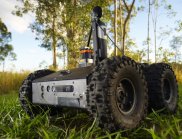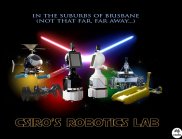May-the-fourth be with the bots
As science-fiction fans around the world gear up to celebrate some of the most popular robots ever created on global Star Wars Day (otherwise known as May-the-fourth-be-with-you Day), CSIRO has released details about its latest crop of robots which indicate advances in ICT research will see closer collaboration between people and robots in the not so distant future.
“The next generation of assistive robots which are specifically designed to help humans in the workplace will increase efficiencies and improve safety.”
Dr Jonathan Roberts, Director, CSIRO Autonomous Systems Laboratory
CSIRO’s ‘Yoda of robotics’, Dr Jonathan Roberts says the next generation of assistive robots which are specifically designed to help humans in the workplace will increase efficiencies and improve safety. He believes this trend reveals interesting similarities and differences between today’s robots to those first seen in the epic George Lucas series 35 years ago.
“The main difference is that the droids in Star Wars are capable of far more general tasks than what robots are designed to perform today and often lend a hand in all sorts of applications. For example, R2-D2 is a droid designed to help work spacecraft, yet he also occasionally subs as an excellent spy and cocktail waiter,” says Jonathan Roberts, Director of CSIRO’s Autonomous Systems Lab.
“Robots on Earth today tend to be made for very specific tasks and are not particularly easy to train to perform activities outside their intended scope. However, we are currently developing robotic systems which are designed to assist people in a variety of circumstances. While some may work alongside people in a factory others are designed for tasks considered impractical or too hazardous for humans. This is exactly what droids do in the Star Wars universe, except of course droids help all types of weird creatures, not just people.”
Some of the latest robots which are being developed by CSIRO’s Autonomous Systems Lab to help humans include:
- Telepresence Robot – offering a solution which allows a robot to move around and offer a virtual video-conferencing experience. From national museums to under the Great Barrier Reef, this technology will eventually allow all Australians with a high speed broadband connection especially those in rural and regional areas to experience and access a range of our national landmarks or treasures, despite the tyranny of distance.
- Stealth Robot – move over David Attenborough because this robot aims to track and observe animals in their natural habitat without being detected. Using acoustics to monitor surrounding sounds, the robot uses them to mask its motions so that it can move without being detected and appear as part of the natural habitat.
- Starbug – an inexpensive, miniature autonomous underwater vehicle ideal for data collection and ecosystem surveys. It helps to get marine data from areas which humans wouldn’t be able to travel.
- Helicopter Robot – an unmanned automatic helicopter designed to remotely inspect dangerous or hard to get to infrastructure such as powerlines, buildings and bridges.
- Hexapod Robot – with a similar aesthetic to an insect, this multi-legged robot can be used for monitoring and mapping uneven and unstructured terrain which can be difficult to navigate with wheeled robots. It has 18 servo motors which provide rich sensory feedback to the control software allowing it to detect when the robot interacts with an obstacle and also to assess the type of terrain it is traversing on.
Star Wars fans are encouraged to join the conversation by tweeting @CSIRONews what their favourite robot is using the #maythefourthbewithyou hash tag.
CSIRO will also be launching a whitepaper outlining further details on how assistive robotics can be used in the manufacturing industry during next week’s National Manufacturing Week (7-10 May) conference.
Media resources
Click image for high resolution version


